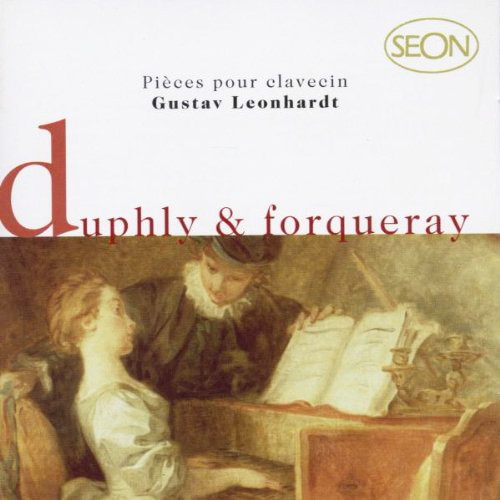 |
1 LP -
6575 038 - (p) 1974
|
 |
| 2 CDs -
SB2K 60875 - (c) 1999 |
|
PIÈCES DE
CLAVECIN
|
|
|
|
|
|
|
|
| Antoine FORQUERAY (c.1672-1745) |
Suite
No. 1 in D Minor |
|
|
|
|
- Nr.
2 "La Forqueray" (Vivement et d'aplomb)
|
|
4' 18" |
A1
|
|
- Nr. 3 "La Cottin" (Galamment sans
lenteur)
|
|
3' 05" |
A2
|
|
- Nr.
5 "La Portugaise" (Marquè et d'aplomb) |
|
2' 56" |
A3 |
|
- Nr.
6 "La Couperin" (Noblement et marché) |
|
2' 43" |
A4 |
|
Suite
No. 2 in G Major |
|
|
|
|
- Nr.
10 "La Leclair" (Très vivement et détaché) |
|
2' 06" |
A5 |
|
Suite
No. 3 in D Major |
|
|
|
|
- Nr.
12 "La Ferrand" (Détaché, et d'une belle
exécution) |
|
4' 12" |
A6 |
|
- Nr.
13 "La Régente" (Noblement et soutenu)
|
|
4' 35" |
A7 |
|
Suite
No. 4 in G Major |
|
|
|
|
- Nr.
19 "La Marella" (Vivement et marqué) |
|
3' 26" |
B1 |
|
- Nr.
20 "La Clément" (Noblement et détaché) |
|
4' 32" |
B2 |
|
Suite
No. 5 in C Minor |
|
|
|
|
- Nr.
26 "La Rameau" (Majestuesement) |
|
4' 35" |
B3 |
|
- Nr.
27 "La Giugnon" (Vivement et détaché) |
|
5' 02" |
B4 |
|
- Nr.
31 "La Sylva" (Très tendrement) |
|
6' 58" |
B5 |
|
|
|
|
|
| Gustav
Leonhardt, Harpsichord by David Rubio,
Oxford, 1972 after Pascal Taskin
(1723-1793) - Tuning: 1/2 tone below
normal |
|
|
|
|
|
Luogo
e data di registrazione |
|
Doopsgezinde Kerk,
Amsterdam (Holland) - Novembre
1973
|
|
|
Registrazione: live
/ studio |
|
studio |
|
|
Producer /
Recording Supervisor |
|
Wolf Erichson
|
|
|
Recording Engineer
|
|
Dieter Thomsen
|
|
|
Prima Edizione LP |
|
Seon (Philips) | 6575
038 | 1 LP - durata 49' 42" | (p)
1974 | ANA
|
|
|
Edizione CD |
|
Sony | SB2K 60875 | 2
CDs - durata 51' 38" & 49' 42"
| (c) 1999 | ADD
|
|
|
Original Cover
|
|
-
|
|
|
Note |
|
La riedizione in 2 CD
della Sony contiene: nel primo CD
le musiche di Duphly (Seon Philips
6575 017) e nel secondo CD le
musiche di Forqueray (Seon Philips
6575 038).
|
|
|
|
|
Their name
itself is an indication of
the Scottish origins of the
Forqueray family of
composers. One of their
ancestors had come over to
France in the train of Mary,
Queen of Scots, on the
occasion of her mariage to
Francis II in 1559, and
settled near Melun.
Antoine Forqueray, takes up
at an early age by Louis XIV
as a child prodigy an the
viola da gamba, became in
1689, at the age of 17,
"violiste ordinaire de la
chambre."
According to the fragmentary
account of his life which
hat come down to us, the
king had him brought up at
court with the royal pages.
In later years Philip Duke
of Orleans was the patron
who supported the by now
highly esterned
instrumentalist, and
Forqueray paid homage to him
in one of the pieces in this
selection, "La Régente."
In 1736, 13 years after the
death of the Duke of
Orleans, we find Forqueray
mentioned as a "veteran" of
the musical household of
Louis XV. The 64-year-old
composer had in the maintime
retired to Nantes, where he
died in June 1745. Some of
his compositions were
published in 1747 by his
son, Jean-Baptiste-Antoine
Forqueray, who like his
father whs a viola da gamba
virtuoso much estemated in
court and aristocratic
circles. These "Pièces de
Clavecin" he dedicated to
Maria-Josepha of Saxony,
whose marriage to the
Dauphin took place in the
same year. Since
Jean-Baptiste Forqueray's
young wide was reputed to be
an autstanding performer on
the harpsichord, it is
fairly safe to assume that
she collaborated in the
arranging of these works,
which were originally
written for viola da gamba.
About the middle of the
century the viola da gamba's
place in musical favour had
ben taken by the fuller
toned violoncellos, and
Jean-Baptiste Forqueray must
have had their greater
resonance in mind when be
reset 19 of his father's
viola da gamba pieces. As
Colin Tilney, points out in
his introduction to the
French edition of the
"Pièces de Clavecin,"
Forqueray has upgrated the
second viola da gamba part
from its modest accompanying
role, while strictly
preserving in the bass the
dialogue between of the two
now almost equal voices.
Finally, a few words about
the titles of certain of the
"Pièces." On the occasion of
the marriage of
Jean-Baptiste-Antoine,
Rameau had composed that one
of his "Pièces de Clavecin
en Concert" titled "La
Forqueray." In return we
have here a musical
portratit by Antoine
Forqueray of his great
contemporary, preceded in
the first suite by a piece
in homage to Couperin. No
last wurthly of note is that
section of the G major suite
headed "La Leclair." It is
probable that Jean-Marie
Leclair, who came to Paris
from Turin 1723, gave
Forqueray that contact with
Italian music which was to
have a lasting influence on
his work. In addition to
this, however, Forqueray
enjoyed a personal
relationship with the
violinist Jean-Pierre
Guignon, who introduced the
violin works of Vivaldi to
Parisian society. Forqueray
also performed with Guignon
in 1727 in Rennes and nantes
and dedicated to him a
section of the C minor
suite.
Hans
Christoph Worbs
|
  |
|
|